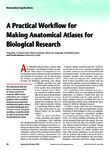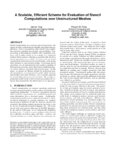TO
| Creator | Title | Description | Subject | Date | ||
|---|---|---|---|---|---|---|
| 26 |
 | Sikorski, Kris | A note on optimal algorithms for fixed points | We present a constructive lemma that we believe will make possible the design of nearly optimal 0(dlog | ) cost algorithms for computing eresidual approximations to the fixed points of d-dimensional nonexpansive mappings with respect to the infinity norm. This lemma is a generalization of a two-... | Fixed points; Constructive lemma | 2009 |
| 27 |
 | Lyche, Tom | A note on the Oslo algorithm | The Oslo algorithm is a recursive method for updating the B-spline representation of a curve or tensor product surface when extra knots are added. In the present note the derivation of this method is simplified. | Oslo algorithm; B-spline; Curve product surface; Tensor product surface | 1987 |
| 28 |
 | Sloan, Peter-Pike | A painterly approach to human skin | Rendering convincing human figures is one of the unsolved goals of computer graphics. Previous work has concentrated on modeling physics of human skin. We have taken a different approach. We are exploring techniques used by artists, specifically artists who paint air-brushed portraits. Our goal is t... | Human skin | 1999 |
| 29 |
 | Parke, Frederic Ira | A parametric model for human faces | This report presents a computer model for the representation of human faces. This three-dimensional, parametric model produces shaded facial images. The face, constructed of polygonal surfaces, is manipulated through the use of parameters which control interpolation, translation, rotation and scalin... | Parametric model; Human face | 1975 |
| 30 |
 | Gopalakrishnan, Ganesh | A partial order reduction algorithm without the Proviso | This paper presents a partial order reduction algorithm, called Two phase, that preserves stutter free LTL properties. Two phase dramatically reduces the number of states visited compared to previous partial order reduction algorithms on most practical protocols. The reason can be traced to a step o... | Order reduction algorithm; Proviso step | 1998 |
| 31 |
 | Brunvand, Erik L. | A partial scan methodology for testing self-timed circuits | This paper presents a partial scan method for testing control sections of macromodule based self-timed circuits for stuck-at faults. In comparison with other proposed test methods for self-timed circuits, this technique offers better fault coverage than methods using self-checking techniques, and ... | 1995 | |
| 32 |
 | Brunvand, Erik L. | A partial scan methodology for testing self-timed circuits | This paper presents a partial scan method for testing control sections of macromodule based self-timed circuits for stuck-at faults. In comparison with other proposed test methods for self-timed circuits, this technique offers better fault coverage than methods using self-checking techniques, and re... | Self-timed circuits; Testing | 1995 |
| 33 |
 | McDirmid, Sean; Hsieh, Wilson C. | A path-precise analysis for property synthesis | Recent systems such as SLAM, Metal, and ESP help programmers by automating reasoning about the correctness of temporal program properties. This paper presents a technique called property synthesis, which can be viewed as the inverse of property checking. We show that the code for some program pro... | Property synthesis; Property codes | 2003-12-01 |
| 34 |
 | Thompson, Cynthia A. | A personalized system for conversational recommendations | Increased computing power and theWeb have made information widely accessible. In turn, this has encouraged the development of recommendation systems that help users find items of interest, such as books or restaurants. Such systems are more useful when they personalize themselves to each user?s p... | Adaptive Place Advisor; Recommendation systems | 2002-06-26 |
| 35 |
 | Regehr, John | A practical logic framework for verifying safety properties of executables | We present a novel program logic, Lf , which is designed on top of a Hoare logic, but is simpler, more flexible and more scalable. Based on Lf , we develop a framework for automatically verifying safety properties of executables. It utilizes a whole-program interprocedural abstract interpretation to... | 2011-01-01 | |
| 36 |
 | Hansen, Charles D. | A practical workflow for making anatomical atlases for biological research | An anatomical atlas provides a detailed map for medical and biological studies of anatomy. These atlases are important for understanding normal anatomy and the development and function of structures, and for determining the etiology of congenital abnormalities. Unfortunately, for biologists, generat... | 2012-01-01 | |
| 37 |
 | Gouraud, Henri | A programmer's guide to PDP-10 euler | This manual describes the EULER language as implemented on the DEC PDP-10 computer. EULER is a block-structured language, similar to Algol-60 but simplified by omitting type declarations and by altering the way procedures are defined and called. PDP-10 EULER includes features for list-and array-mani... | EULER language | 1970 |
| 38 |
 | Watkins, Gary Scott | A real time visible surface algorithm | With the increasing use of computer graphics, a need is growing for a processor capable of displaying solid objects. Environmental simulation and architectural modeling are only two areas that would benefit from such a diplay processor. This dissertation describes an algorithm designed for such a ... | Surface algorithm | 1970 |
| 39 |
 | Kirby, Robert Michael | A scalable, efficient scheme for evaluation of stencil computations over unstructured meshes | Stencil computations are a common class of operations that appear in many computational scientific and engineering applications. Stencil computations often benefit from compile-time analysis, exploiting data-locality, and parallelism. Post-processing of discontinuous Galerkin (dG) simulation solutio... | 2013-01-01 | |
| 40 |
 | George, Lal | A scheduling strategy for shared memory multiprocessors | An efficient scheduling strategy for shared memory multiprocessors is described. The rapid dissemination of tasks to available procesors and ready queues is crucial to the performance of any parallel system. Such overheads determine the attainable speedup and performance of the system. Poor techniq... | Shared memory multiprocessors | 1990 |
| 41 |
 | Fujimoto, Richard M. | A shared memory algorithm and proof for the alternative construct in CSP | Communicating Sequential Processes (CSP) is a paradigm for communication and synchronization among distributed processes. The alternative construct is a key feature of CSP that allows nondeterministic selection of one among several possible communicants. Previous algorithms for this construct assume... | Shared memory algorithm; Communicating Sequential Processes; CSP | 1987 |
| 42 |
 | Baxter, Brent S. | A standard magnetic tape format for digital image exchange | This proposal describes a simple yet flexible magnetic tape format for exchanging digital image information. Multi-dimensional arrays of raster scan data are stored as sequential files, with descriptive information related to the sefiles stored in an initial directory file. Directory information is ... | Raster scan data | 1981 |
| 43 |
 | Henderson, Thomas C. | A study of Pierce's group generator | Pierce describes an approach to map learning with uninterpreted sensors and effectors. As part of that, he describes a sensor grouping generator operator that attempts to arrange similar sensors into groups. Here we review that work and place it in a more strenuous statistical validation framewor... | Pierce's group; Map learning; Sensor grouping generator | 2010 |
| 44 |
 | Catmull, Edwin | A subdivision algorithm for computer display of curved surfaces (CSTD-74-006) | This report presents a method for producing computer shaded pictures of curved surfaces. Three-dimensional curved patches are used, as contrasted with conventional methods using polygons. The method subdivides a patch into successively smaller subpatches until a subpatch is as small as a raster-elem... | Computer animation | 1974-12 |
| 45 |
 | Henderson, Thomas C. | A survey of dextrous manipulation | The development of mechanical end effectors capable of dextrous manipulation is a rapidly growing and quite successful field of research. It has in some sense put the focus on control issues, in particular, how to control these remarkably humanlike manipulators to perform the deft movement that we t... | Dextrous manipulation | 1986 |
| 46 |
 | Berzins, Martin | A survey of high level frameworks in block-structured adaptive mesh refinement packages | Over the last decade block-structured adaptive mesh refinement (SAMR) has found increasing use in large, publicly available codes and frameworks. SAMR frameworks have evolved along different paths. Some have stayed focused on specific domain areas, others have pursued a more general functionality, p... | 2014-01-01 | |
| 47 |
 | Gopalakrishnan, Ganesh; Kirby, Robert Michael II | A survey of MPI related debuggers and tools | Message Passing Interface is a widely used standard in the High Performance and Scienti c Computing Community for writing programs that can exploit the capability of parallel platforms. However, the inherent complexity and the size of the communication standard have made it difficult for programm... | Message Passing Interface; MPI; Debuggers | 2007 |
| 48 |
 | Sobh, Tarek M. | A survey on sensor classifications for industrial applications | The importance of sensors in industrial applications is a result of the introduction of many robotics, automation, and intelligent control techniques into factory floors. Research and improvements need to be continuously performed to meet the challenges in automation and manufacturing applications i... | Sensor classifications; Industrial applications; Sensors | 1995 |
| 49 |
 | Gopalakrishnan, Ganesh | A symbolic partial order reduction algorithm for rule based transition systems | Partial order reductions are a class of methods that attempt to reduce the state space that must be explored to verify systems by explicit state enumeration. Partial order reduction algorithms have been successfully incorporated into tools such as Spin and VFSM-valid. However, current partial ord... | Partial order reductions; Partial order reduction algorithms; SAT solver; Rule based transition systems | 2003-12-01 |
| 50 |
 | Henderson, Thomas C. | A systolic array implementation of discrete relaxation algorithm | Discrete Relaxation techniques have proven useful in solving a wide range of problems in digital signal processing, artificial intelligence, machine vision, and VLSI engineering, etc. A conventional hardware design for an 8-label 8-object Discrete Relaxation Algorithm (DRA) requires three 4K memory... | Discrete Relaxation algorithm; Systolic array | 1986 |
